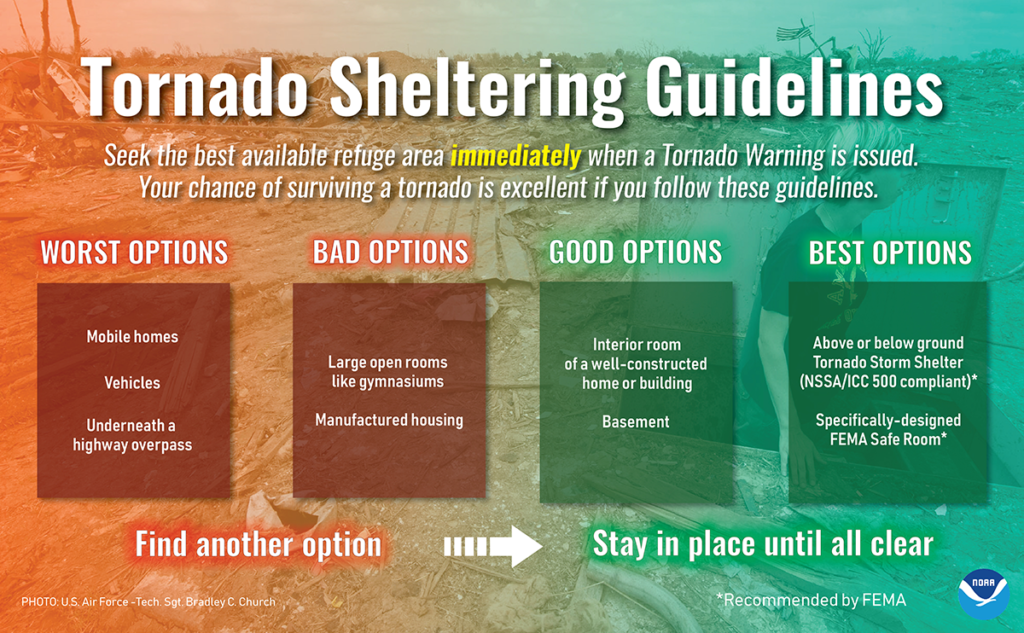Stay Safe: Tornado Preparedness Steps in English

Tornadoes are one of the most destructive natural disasters, causing significant damage to property and loss of life. It’s essential to be prepared for a possible tornado, especially if you live in a tornado-prone area. In this article, we’ll discuss some tornado preparedness steps to help you stay safe.
What is a Tornado?
A tornado is a rotating column of air that extends from a thunderstorm to the ground. They can form quickly and without warning, often appearing as a dark, funnel-shaped cloud. Tornadoes can reach wind speeds of up to 300 miles per hour and cause significant damage to anything in their path.
Know the Signs of a Tornado
Being able to recognize the signs of a tornado can help you take action quickly. Some of the warning signs to look out for include:
- A dark, greenish sky
- Loud, continuous roar or rumble, similar to the sound of a freight train
- Hailstones larger than golf balls
- Debris flying through the air
- A funnel-shaped cloud
If you see any of these signs, take immediate action to protect yourself.
Have a Tornado Plan
Having a plan in place can help you and your family stay safe during a tornado. Your plan should include:
- A designated safe room or shelter area in your home, preferably in the basement or lowest level
- An emergency kit that includes a first aid kit, flashlights, extra batteries, a NOAA weather radio, and enough food and water for at least three days
- A communication plan that outlines how you will contact each other if you become separated
Make sure everyone in your family knows the plan and has practiced it.
Stay Informed
It’s crucial to stay informed about the weather conditions in your area. Listen to your local news stations and keep a NOAA weather radio on hand to receive alerts and warnings.
Monitor Your Environment
Pay attention to the weather conditions around you. If you see or hear any of the warning signs of a tornado, take immediate action to protect yourself.
Take Shelter
If a tornado warning is issued for your area, take shelter immediately. Head to your designated safe room or shelter area and cover yourself with blankets, pillows, or a mattress to protect yourself from flying debris.
Stay Away from Windows
Stay away from windows and exterior walls during a tornado. Flying debris can shatter windows and cause significant injuries.
Protect Your Head
Wear a helmet or cover your head and neck with your arms to protect yourself from falling debris.
After the Tornado
After the tornado has passed, stay in your safe room or shelter area until you hear the all-clear. Be cautious when leaving your shelter and be aware of any potential hazards, such as downed power lines or gas leaks.
Tornado Preparedness Checklist
Here’s a quick checklist to help ensure you’re prepared for a tornado:
- Have a designated safe room or shelter area in your home
- Create an emergency kit
- Develop a communication plan
- Stay informed about the weather conditions in your area
- Monitor your environment for any warning signs of a tornado
- Take shelter immediately if a tornado warning is issued
- Stay away from windows and exterior walls
- Protect your head and neck with a helmet or your arms
- Stay in your safe room or shelter area until you hear the all-clear
Conclusion
Tornadoes can be devastating, but being prepared can help you stay safe. Know the signs of a tornado, have a plan in place, stay informed, and take shelter immediately if a tornado warning is issued. By following these tornado preparedness steps, you can help protect yourself and your family.
FAQs
What should I do if I’m caught outside during a tornado?
If you’re caught outside during a tornado, seek shelter in a sturdy building, or lie flat in a low-lying area and cover your head and neck with your arms.
How can I protect my pets during a tornado?
Bring your pets inside with you to your designated safe room or shelter area. If you have to evacuate, take your pets with you.
Can I open windows during a tornado to equalize pressure?
No. Opening windows during a tornado can actually cause more damage and create a hazardous situation.
What should I do if I’m driving during a tornado?
If you’re driving during a tornado, try to find shelter immediately. If you can’t find shelter, stay in your car with your seatbelt on, and cover your head and neck with your arms.
How can I help my neighbors after a tornado?
Check on your neighbors to see if they need help or assistance. Offer to help clean up debris or provide food and water if needed.
Deja una respuesta